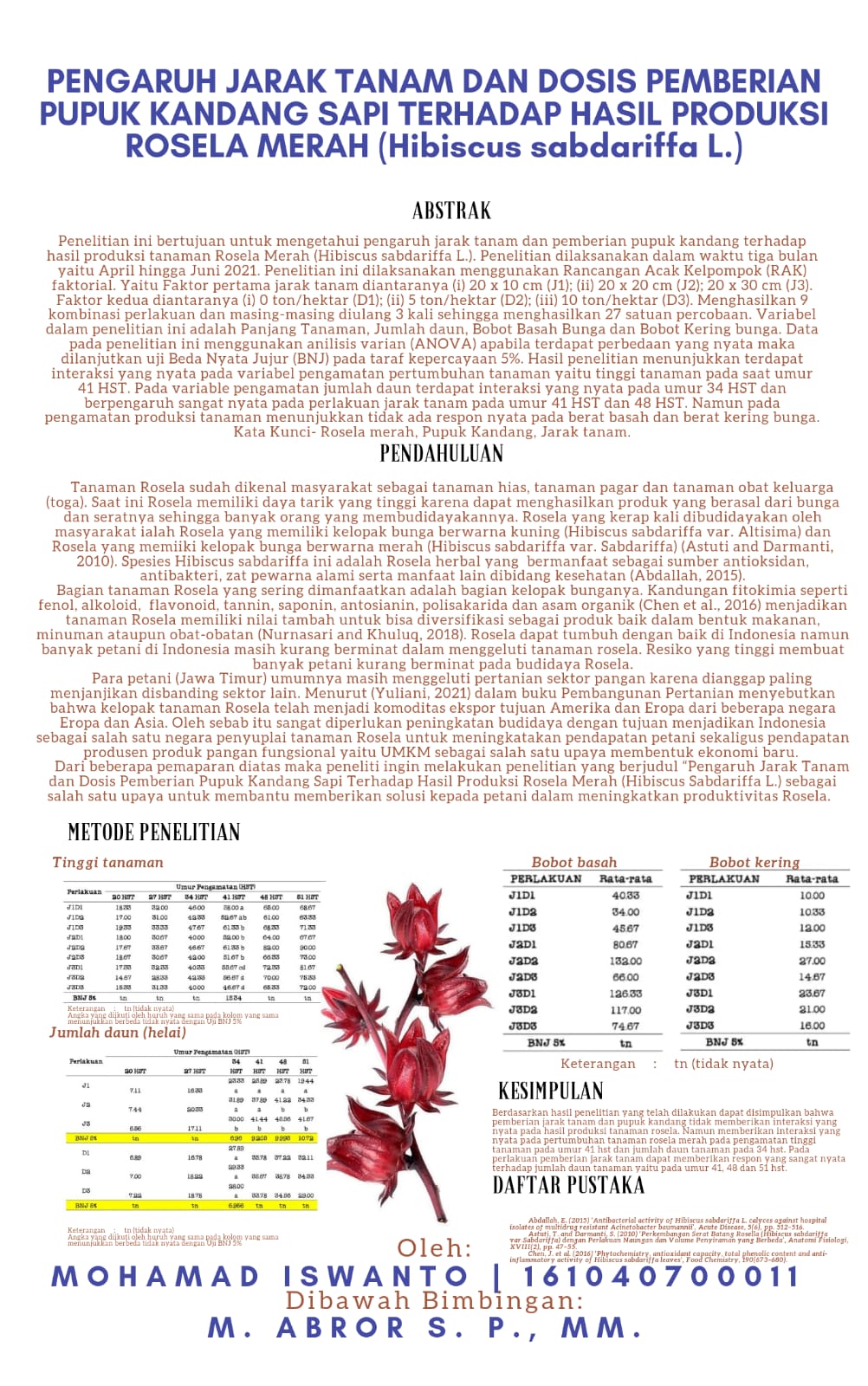The Effect Of Planting Distance and Dosage Of Fertilizing Cow Manage On Production Products Red Rosella (Hibiscus sabdariffa L.)
Pengaruh Jarak Tanam dan Dosis Pemberian Pupuk Kandang Sapi Terhadap Hasil Produksi Rosela Merah (Hibiscus sabdariffa L.)
DOI:
https://doi.org/10.21070/pels.v2i2.1267Keywords:
Red roselle, Manure, SpacingAbstract
This study aims to determine the effect of spacing and application of manure on the production of Red Roselle (Hibiscus sabdariffa L.). The research was carried out in three months, from April to June 2021. This research was carried out using a factorial Randomized Group Design (RAK). Namely, the first factor is the spacing between (i) 20 x 10 cm (J1); (ii) 20 x 20 cm (J2); 20 x 30 cm (J3). The second factor includes (i) 0 ton/hectare (D1); (ii) 5 tons/ha (D2); (iii) 10 tons/ha (D3). Produced 9 treatment combinations and each was repeated 3 times resulting in 27 experimental units. The variables in this study were plant length, number of leaves, flower wet weight and flower dry weight. The data in this study used analysis of variance (ANOVA) if there was a significant difference, then the Honest Significant Difference (BNJ) test was continued at the 5% confidence level. The results showed that there was a significant interaction on the observed variables of plant growth, namely plant height at 41 DAP. In the observation variable the number of leaves there was a significant interaction at the age of 34 DAP and a very significant effect on the spacing treatment at 41 DAP and 48 DAP. However, the observation of plant production showed no significant response to the wet weight of flowers and dry weight of flowers.
Downloads
References
[2] E. Abdallah, “Antibacterial activity of Hibiscus sabdariffa L. calyces against hospital isolates of multidrug resistant Acinetobacter baumannii,” Acute Dis., vol. 5, no. 6, pp. 512–516, 2015.
[3] J. Chen et al., “Phytochemistry, antioxidant capacity, total phenolic content and anti-inflammatory activity of Hibiscus sabdariffa leaves,” Food Chem., vol. 190, no. 673–680, 2016.
[4] E. Nurnasari and A. D. Khuluq, “Potensi Diversifikasi Rosela Herbal (Hibiscus sabdariffa L.) untuk Pangan dan Kesehatan,” Bul. Tanam. Tembakau, Serat Miny. Ind., vol. 9, no. 2, p. 82, 2018, doi: 10.21082/btsm.v9n2.2017.82-92.
[5] Yuliani, “Rosela (Hibiscus sabdariffa Linn): Kandungan Gizi, Manfaat Untuk Kesehatan dan Aplikasinya Pada Produk Pangan,” in Pembangunan Pertanian, 2021, pp. 153–160.
[6] Yayang, N. Amir, and H. Hawalid, “Pengaruh Jarak Tanam Dan Takaran Pupuk Kotoran Ayam Terhadap Pertumbuhan Dan Produksi Tanaman Kacang Tanah (Arachis hypogaea L.),” J. Chem. Inf. Model., pp. 1689–1699, 2013.
[7] Sutanto and Rahman, Penerapan Pertanian Organik. Yogyakarta: Kanisius, 2012.
[8] V. Wulandari, “Pengaruh pemberian beberapa dosis pupuk kandang ayam terhadap pertumbuhan dan hasil tanaman rosella (Hibiscus Sabdariffa L.) Di Tanah Ultisol.,” Padang, 2011.
[9] L. Samuli, L. Karimuna, and L. Sabaruddin, “Produksi kedelai (Glycine max L.Merrill) pada Berbagai Dosis bokashi Kotoran Sapi,” Penelit. Agron., vol. 1, no. 2, pp. 145–147, 2012.
[10] Y. E. Susilowati and R. Sarwitri, “Meningkatkan hasil tanaman stroberi dengan urine kelinci,” J. Ilmu Pertan. Trop. dan Subtrop., vol. 3, no. 1, pp. 25–29, 2018.
[11] A. S. Alim, T. Sumarni, and Sudiarso, “Pengaruh Jarak Tanam dan Defolasi Daun pada Pertumbuhan dan Hasil Tanaman Kedelai (Glycine max L.),” J. Produksi Tanam., vol. 5, no. 2, pp. 273–280, 2017.




